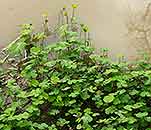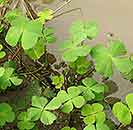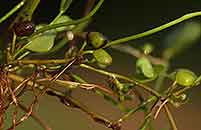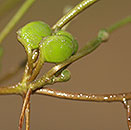Marsilea minuta L. var. minuta
Synonyms |
Marsilea crenulata Desv. |
|---|---|
Common name |
|
Description |
Rhizome slender to fairly stout, long creeping, repeatedly branched, internodes 0.5–20 cm long. Floating form: stipe up to 26 cm long, slender, hairless. Leaflets 0.4–2.5(–3) cm long, 0.3–2.2(–2.8) cm wide, broadly obovate, outer margin rounded, entire to shallowly irregular, hairless, brownish suberous streaks between the veins of the lower surface. Dry land form: stipe 2–8(–15) cm long. Leaflets 0.4–2.5(–3) cm long, 0.3–2.2(–2.8) cm wide, obovate, outer margins subentire to shallowly incised, slightly hairy. Sporocarps: clustered in groups of 2-5, size variable, 2.8-4 mm long, 2.4-3 mm wide, 0.8-1.4 mm thick, dark brown to almost matt black, broadly oblong-elliptic in lateral view, outer side rounded, vertical cross-section elliptic; densely appressed hairy when young becoming quite hairless with age; its long axis usually at a right angle to the pedicel which is usually longer tahn the sporocarp; lower and upper tooth prominent, upper tooth as long as or slightly longer than lower tooth; pedicels 3-7 mm long, cylindrical, stout, erect or gently curved upwards, free or branching once, arising from the leaf axil or the base of the stipe, sometimes one above the other. Sori 8-12. |
Notes | Recognizable by two prominent teeth on sporocarp and only a few sporocarps arising both from axil and along base of stipe. |
Derivation | minuta: very small, unclear since no parts of the plant are extremely small. |
Habitat | Seasonal or perennial pools in vleis, lake edges, flood plains of larger river systems, seasonally swamped grassland depressions, rice fields. |
Distribution worldwide | Africa, Comoros Isl., Madagascar, the Mascarenes, India. |
Distribution in Africa |
Algeria, Angola, Benin, Burkina Fasso, Burundi, Cameroon, Central African Republic, Chad, Congo, Dem. Republic of Congo, Egypt, Equatorial Guinea (incl. Bioko), Ethiopia, Ghana, Guinea Bissau, Kenya, Mali, Morocco and Western Sahara, Mozambique, Nigeria, Rwanda, Senegal, Sudan and South Sudan, Swaziland, Tanzania , Togo, Uganda, Zambia, Zimbabwe. |
Growth form |
Aquatic, terrestrial. |
Literature |
|



